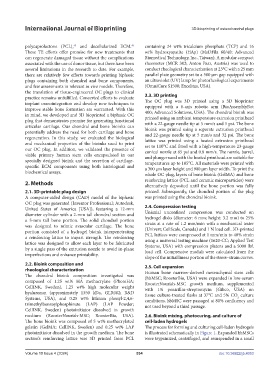Page 542 - IJB-10-4
P. 542
International Journal of Bioprinting 3D-bioprinting of osteochondral plugs
polycaprolactone (PCL), and decellularized ECM. containing 24 wt% tricalcium phosphate (TCP) and 16
46
45
These TE efforts offer promise for new treatments that wt% hydroxyapatite (HAp) (MeDFila 60/40; Advanced
can regenerate damaged tissue without the complications Biomedical Technology, Inc., Taiwan). A modular compact
associated with the use of donor tissue, but there have been rheometer (MCR 302; Anton Paar, Austria) was used to
several limitations in the research to date. For example, conduct rheological characterization at 23°C with a 25 mm
there are relatively few efforts towards printing biphasic parallel plate geometry set to a 500 µm gap equipped with
plugs containing both chondral and bone components, an ultraviolet (UV) lamp for photorheological experiments
and few assessments in relevant in vivo models. Therefore, (OmniCure S1500; Excelitas, USA).
the translation of tissue-engineered OC plugs to clinical
practice remains unfulfilled. Concerted efforts to evaluate 2.3. 3D printing
implant osseointegration and develop new techniques to The OC plug was 3D printed using a 3D bioprinter
improve stable bone formation are warranted. With this equipped with a 6-axis robotic arm (BioAssemblyBot
in mind, we developed and 3D bioprinted a biphasic OC 400; Advanced Solutions, USA). The chondral bioink was
plug that demonstrates promise for generating functional printed using an ambient temperature extrusion printhead
with a 22-gauge needle tip at 5 mm/s and 5 psi. The bone
articular cartilage. Our chondral and bone bioinks can bioink was printed using a separate extrusion printhead
potentially address the need for both cartilage and bone and 22-gauge needle tip at 5 mm/s and 32 psi. The bone
regeneration. In this study, we evaluated the biological lattice was printed using a heated extrusion printhead
and mechanical properties of the bioinks used to print set to 110°C and fitted with a high-temperature 23-gauge
our OC plug. In addition, we validated the presence of conical nozzle at 85 psi and 0.8 mm/s. The nozzle, barrel,
viable primary human stem cells encapsulated in our and plunger used with the heated printhead are suitable for
specially designed bioink and the secretion of cartilage- temperatures up to 185°C. All materials were printed with
specific ECM components using both histological and a 300 µm layer height and 900 µm layer width. To print the
biochemical assays. whole OC plug, layers of bone bioink (GelMA) and bone
reinforcing lattice (PCL and ceramic microparticles) were
2. Methods alternatively deposited until the bone portion was fully
2.1. 3D-printable plug design printed. Subsequently, the chondral portion of the plug
A computer-aided design (CAD) model of the biphasic was printed using the chondral bioink.
OC plug was generated (Inventor Professional; Autodesk,
United States of America [USA]), featuring a 12-mm 2.4. Compression testing
diameter cylinder with a 2-mm tall chondral section and Uniaxial unconfined compression was conducted on
a 5-mm tall bone portion. The solid chondral portion hydrogel disks (diameter: 6 mm; height: 3.2 mm) to 25%
was designed to mimic avascular cartilage. The bone strain at a rate of 1.2 mm/min with a mechanical tester
(Univert; CellScale, Canada) and 1 N load cell. 3D-printed
portion consisted of a hydrogel bioink interpenetrating PCL lattices were compressed at 1 mm/min to 40% strain
a reinforcing lattice to impart strength. The reinforcing using a universal testing machine (1620-CC; Applied Test
lattice was designed to allow each layer to be fabricated Systems, USA) with compression platens and a 5000 lbf.
by a single pass of the extrusion nozzle to avoid in-plane load cell. Compressive moduli were calculated from the
imperfections and enhance printability.
slope of the initial linear portion of the stress–strain curves.
2.2. Bioink composition and 2.5. Cell expansion
rheological characterization Human bone marrow-derived mesenchymal stem cells
The chondral bioink composition investigated was (hbMSC; RoosterBio, USA) were expanded in low-serum
composed of 1.25 wt% HA methacrylate (PhotoHA; RoosterNourish-MSC growth medium, supplemented
CellINK, Sweden), 1.25 wt% high molecular weight with 1% penicillin-streptomycin (Gibco, USA) on
hyaluronan (approximately 1350 kDa, GLR002; R&D tissue culture-treated flasks at 37°C and 5% CO culture
Systems, USA), and 0.25 wt% lithium phenyl-2,4,6- conditions. hbMSC were passaged at 80% confluency and
2
trimethylbenzoylphosphinate (LAP) (LAP Powder; not used beyond a third passage.
CellINK, Sweden) photoinitiator dissolved in growth
medium (RoosterNourish-MSC; RoosterBio, USA). 2.6. Bioink mixing, photocuring, and culture of
The bone bioink was composed of 5 wt% methacrylated cell-laden hydrogels
gelatin (GelMA; CellINK, Sweden) and 0.25 wt% LAP The process for forming and culturing cell-laden hydrogels
photoinitiator dissolved in the growth medium. The bone is illustrated schematically in Figure 1. Expanded hbMSCs
section’s reinforcing lattice was 3D printed from PCL were trypsinized, centrifuged, and resuspended in a small
Volume 10 Issue 4 (2024) 534 doi: 10.36922/ijb.4053

